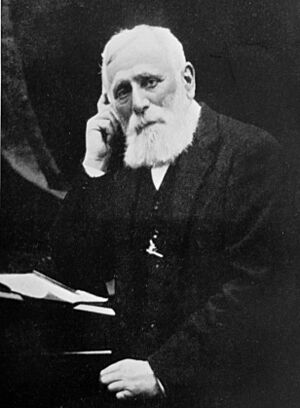Bernhard Samuelson facts for kids
Sir Bernhard Samuelson (born November 22, 1820 – died May 10, 1905) was an important person in British history. He was a successful businessman, a strong supporter of education, and a Liberal politician. He served in the House of Commons, which is part of the UK Parliament, for many years between 1859 and 1895.
Contents
Early Life and Business Beginnings
Bernhard Samuelson was born in Hamburg, Germany. He was the oldest son of Samuel Hermann Samuelson. When he was 14, he started working in his father's office. Later, he trained with a Swiss company in Liverpool.
He became skilled in exporting engineering machines. Soon, he was a manager for a company in Manchester called Sharp, Stewart & Co. In 1848, Samuelson bought a small factory in Banbury. This factory made equipment for farms. He also built large furnaces for making iron in Middlesbrough and Newport.
Political Career in Parliament
In February 1859, Samuelson was elected as a Member of Parliament for Banbury. He served for a short time before the next election. In 1865, he was elected for Banbury again.
Another candidate tried to stop him, saying Samuelson was not a British citizen. But Samuelson proved that his grandfather was born in England. This meant he was allowed to be an MP under a law from 1772. He kept his seat in Parliament until 1895.
In Parliament, Samuelson focused on issues related to industry and technology. He led committees that looked into scientific education, railways, and patents. He was also part of a special group for the Paris Exhibition in 1878. During this time, his businesses grew a lot. By 1872, his Banbury factory made over 8,000 reaping machines. His ironworks also produced more iron, tar, and other products.
Contributions to Education and Industry
Bernhard Samuelson was a member of important engineering groups. These included the Institution of Civil Engineers and the Institute of Mechanical Engineers. He even won a special award called the Telford Medal in 1871 for his work on building blast furnaces. In 1881, he became a Fellow of the Royal Society, which is a group of top scientists.
People saw Samuelson as a fair boss. He helped develop important institutions in Middlesbrough and Cleveland. He strongly believed that technical education was very important. In 1884, he gave a technical institute to Banbury. He was given the title of Baronet in the same year for his work in education.
Family Life
Bernhard Samuelson married Caroline Blundell in 1844. They had eight children together. Their oldest son, Henry, also became a Member of Parliament. Another son, Francis, later inherited the Baronet title. Their youngest son, Herbert, was also honored with a special title.
After Caroline passed away, Bernhard married Lelia Mathilda. She was a nurse who helped during World War I. Sadly, she died in 1915 from an illness she caught while working.
Later Life and Memorial
Samuelson died in London in 1905 when he was 84 years old. He was buried in Torquay. His oldest son built a stone memorial and tomb for him. This memorial is in Hatchford Wood, near Ockham, Surrey. It is called the "Temple of Sleep." The inscription says it holds the remains of Bernhard Samuelson, his wife, and a daughter. Today, the mausoleum is empty, and some of the sculptures have been removed.
Images for kids






